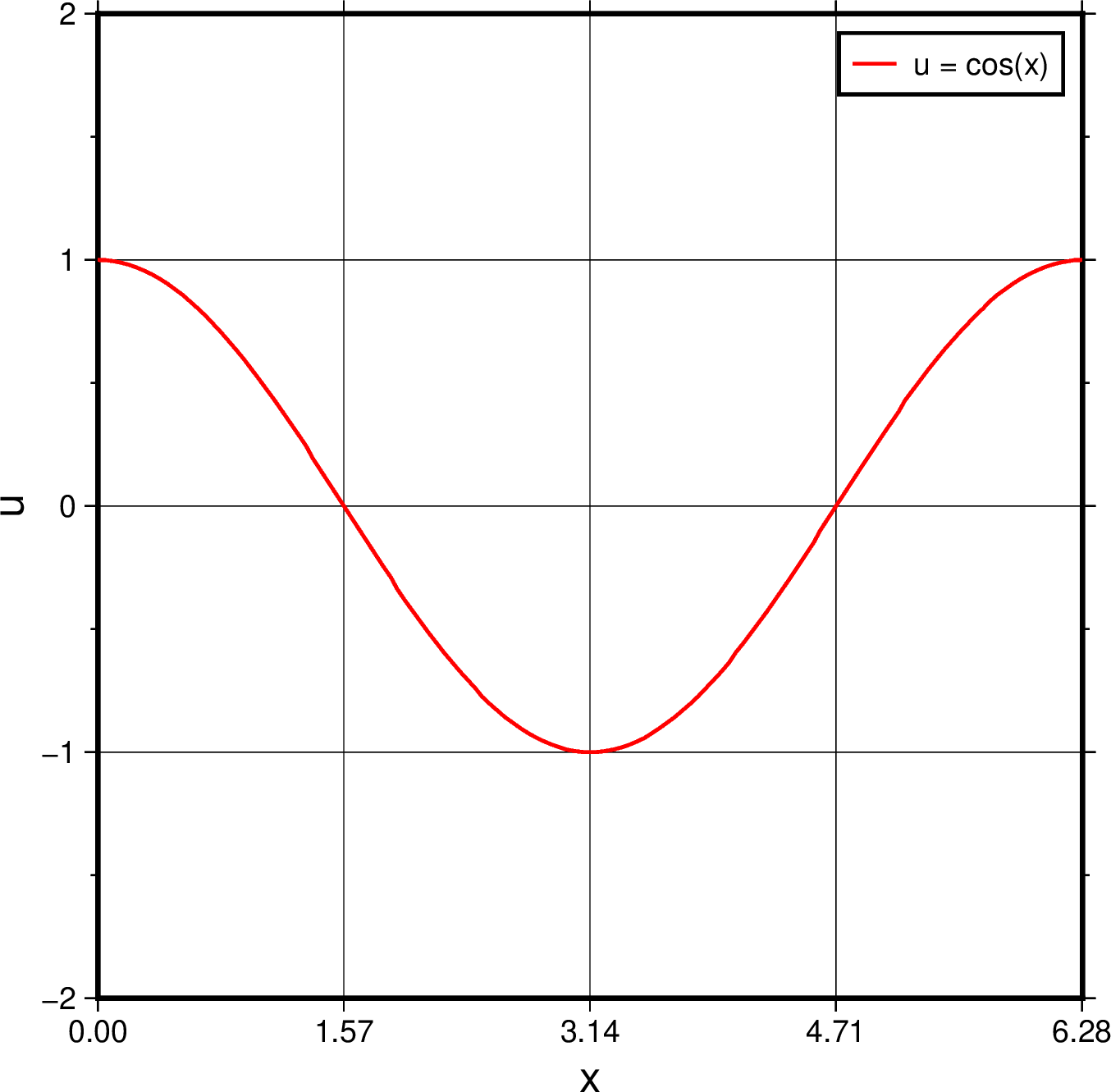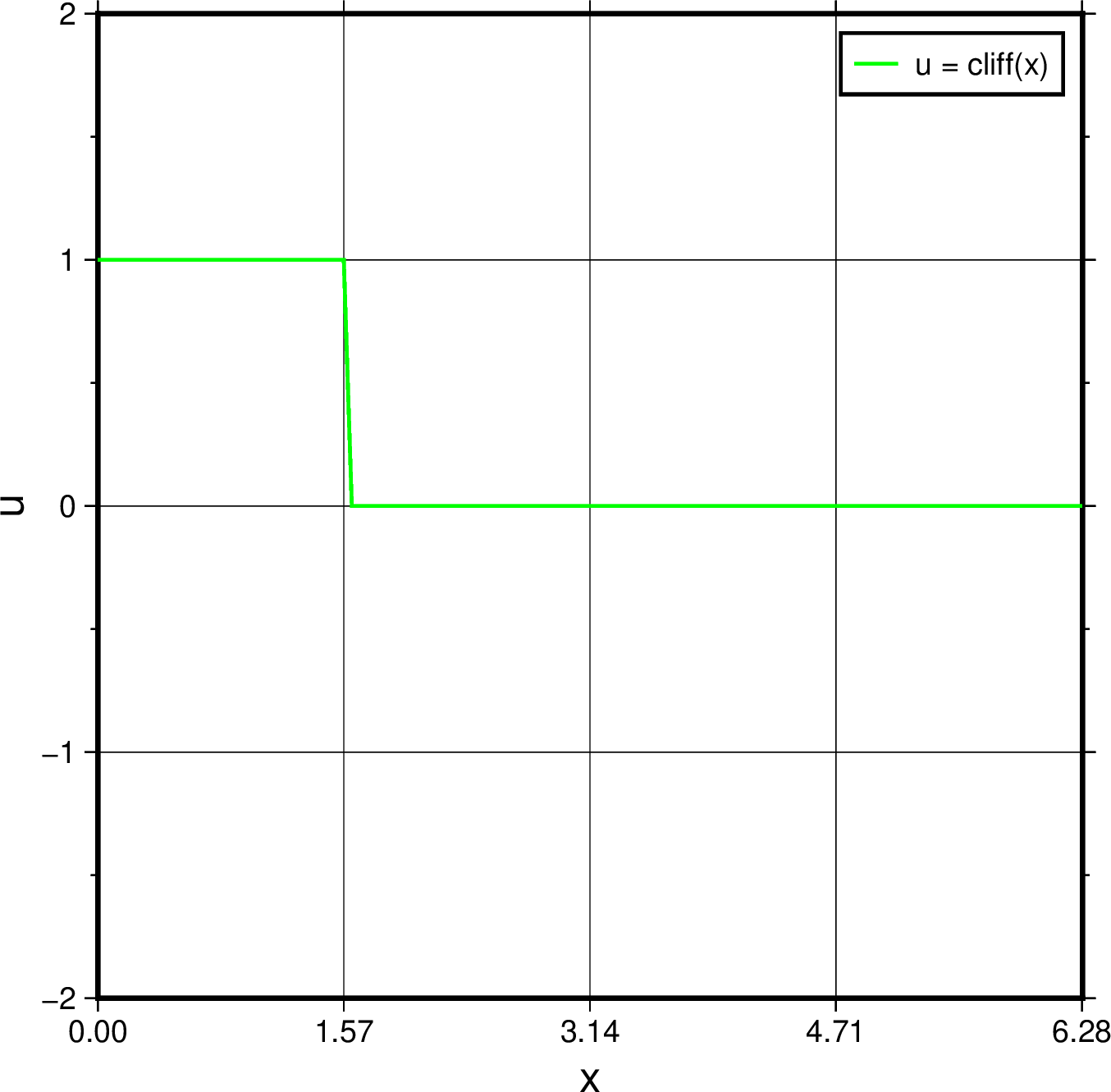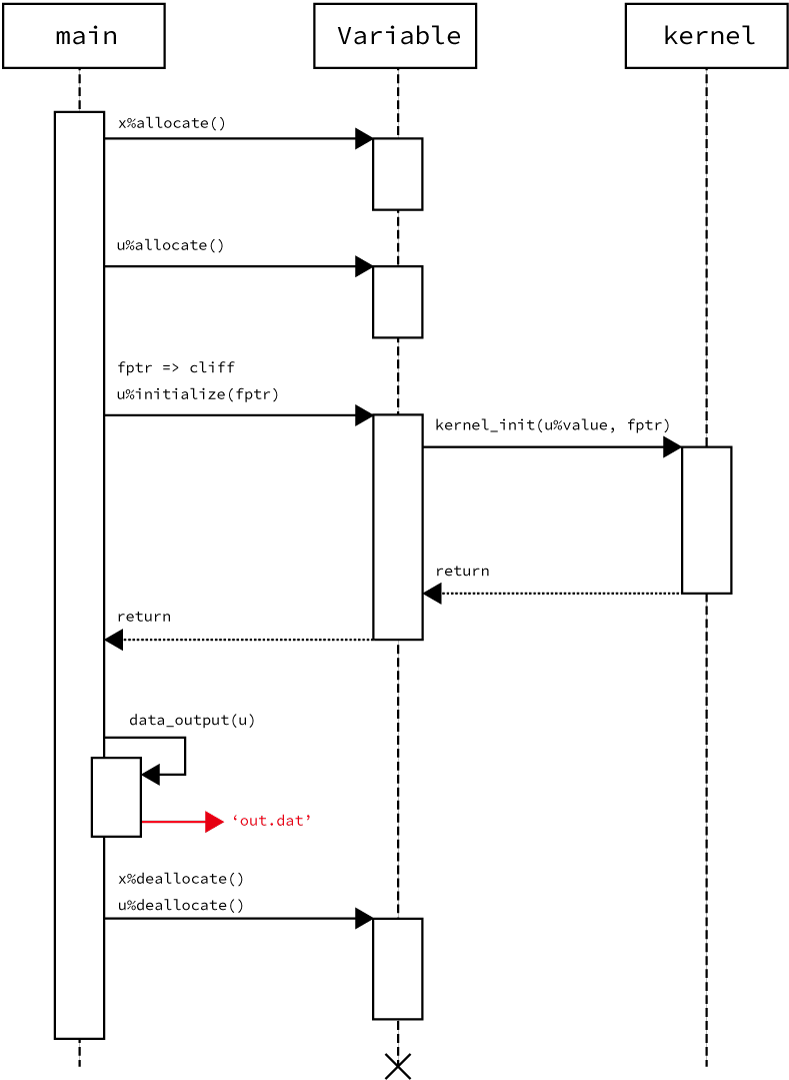Let’s Use Procedure Pointers in Object-Oriented Fortran
Author: Amasaki Shinobu (雨崎しのぶ)
Twitter: @amasaki203
Posted on: 2023-08-28 JST Updated on: 2024-0722
Abstract
This article will cover an implementation of “callback” with procedure pointers in modern Fortran. This allows us to write initial and boundary conditions on numerical computation simply.
Contents
- Introduction
- Preliminary Understanding
- Usage of Procedure Pointers
- Modules and Program written in OOP
- Compilation and Execution
- Conclusion
- Appendixes
Introduction
In classical Fortran, programmers write their code using the procedural programming paradigm. On the other hand, in modern Fortran, the Object-Oriented Programming (OOP) paradigm and procedure pointers are supported starting from Fortran 2003 standards.
In the field of numerical computation, utilizing OOP streamlines source code management, simplifies code modification, and reduces human errors, even though there is some overhead.
This article explores practical implementations of callbacks using procedure pointers in modern Fortran’s object-oriented paradigm.
Preliminary Understanding
In Fortran, object-oriented programming is achieved by
declaring subroutines and functions below the
contains statement of a derived type, associating
them with that type. This is referred to as type-bound
procedures. Type-bound procedures, similar to regular
procedures, can also accept procedure pointers
as arguments.
Procedure pointers are pointers that refer to procedures,
allowing for the switching of procedures and invocation of
associated procedures using the pointer’s names. In Fortran,
they are defined using explicit interface blocks
and procedure statements for procedures. For
exmple:
interface
function f(x) result(res)
real, intent(in) :: x
real :: res
end function f
end interface
procedure(f), pointer :: fptrwhere between the interface and
end interface keywords, there is a section known
as an ‘interface block’, and interface f is then
specified within the parentheses of the procedure
statement.
By using them, it becomes possible to create callbacks, allowing for concise handling of initial and boundary conditions in Fortran numerical computation codes. This further amplifies the ease of changes brought by OOP, enhancing the overall convenience.
In the following, we will examine the simplicity of performing assignments to array components within a derived type via a procedure pointer.
Usage of Procedure Pointers
For example, let’s consider providing a basic sine function as the array of the initial values.

To provide this array of initial values, we can achieve it by utilizing the module implemented with OOP, as explained in the following section. This can be accomplished by executing the following statement:
fptr => dsin
call u%allocate()
call u%initialize(fptr)In the first line, fptr is associated with the
intrinsic function dsin, which is the double
precision sine function. In the second line, the statement
calls the type-bound procedure allocate() of the
derived type u. Finally, in the third line, the
type-bound procedure initialize(fptr) is invoked
with the fptr as its actual argument.
If we want to switch to a cosine function, we can achieve this by simply changing the function that the pointer refers to, as follows:
fptr => dcos
call u%initialize(fptr)where dcos is the intrinsic function that
returns the value of the double precision cosine function.

Procedure pointers can refer to procedures defined by users.
...
fptr => cliff ! fptr refers to the user-defined procedure 'cliff'.
call u%allocate()
call u%initialize(fptr)
call data_output()
contains
! Internal procedure 'cliff'
function cliff(x)
implicit none
real(real64) :: cliff
real(real64), intent(in) :: x
real(real64), parameter :: pi_halved = acos(-1d0)/2d0
! staircase function
if (x <= pi_halved ) then
cliff = 1d0 ! for less than or equal to π/2,
else
cliff = 0d0 ! otherwise.
end if
end function cliff
...Plotting this, we obtain the following a graph of the function.

From above examples, it becomes evident that using a procedure pointer as an argument for type-bound procedures simplifies code writing and enhances flexibility for initializing arrays.
In the next section, we will discuss modules written in an object-oriented manner that achieve these functionalities.
Modules and Program written in OOP
Here, for simplicity, let’s think about an application composed of the following three Fortran codes:
module kernelperforms initialization operation on arrays,module class_Variabledefines the derived typeVariable, andprogram mainis the main program.
The entire three source code files are available on the page of GitHub.
module kernel
This module includes the definition of constant parameters
and a callback process. The initialize subroutine,
which initializes an array using the passed function pointer as
an argument, is implemented as a module procedure.
module kernel
use :: iso_fortran_env, only: real64
implicit none
private
public :: initialize
! Number of discretized points along the computing region
integer, parameter, public :: nx = 2**8+1
! Value of the mathematical constant π (pi)
real(real64), parameter, public :: PI = acos(-1d0)
! Length of the computing region [0, L]
real(real64), parameter, public :: L = 2*PI
! Interval between adjacent points
real(real64), parameter, public :: dx = L/dble(nx-1)
contains
! Callback: Define a subroutine to initialize
! an array using a function pointer.
subroutine initialize(array, fp)
use, intrinsic :: iso_fortran_env, only: real64
implicit none
real(real64), intent(out) :: array(:)
! Declare the procedure pointer for the function.
pointer :: fp
! Interface block for the function pointer 'fp'.
interface
function fp(x) result(res)
use, intrinsic :: iso_fortran_env, only: real64
real(real64), intent(in) :: x
real(real64) :: res
end function fp
end interface
integer :: i
real(real64) :: x
!---- End of specification statements for 'initialize' -----!
!---- Begining executable statements of 'initialize'-----!
! Loop through indices 1 to nx of the array.
do i = 1, nx
! Compute x-axis value
x = dble(i-1)*dx
! Pass the actual argument x to the procedure pointer and
! assign the result to array(i).
array(i) = fp(x)
end do
end subroutine initialize
end module kernelWhen we write the interface block in the
module’s specification statements section, we can declare
procedure pointers such as the following statement in internal
subprogram section:
procedure(fp), pointer :: fptrIn this case, variable names for function pointers cannot be
used if they conflict with names declared in the
interface block.
module class_Variable
This module defines the derived type Variable
with the component array value(:) and the three
type-bound procedures: allocate,
initialize, and deallocate.
These procedures perform following processes respectively:
- The
allocatesubroutine allocates the componentvalueasvalue(nx), - The
initializesubroutine takes a procedure pointer as its argument, and passes both its own object’svaluecomponent and the procedure pointer to theinitializesubroutine of thekernelmodule, and - The
deallocatesubroutine deallocates the componentvalue.
module class_Variable
use, intrinsic :: iso_fortran_env
private
public :: Variable
! Define the derived type 'Variable'
type Variable
! An component 'value'
real(real64), allocatable, public :: value(:)
contains
! type-bound procedures
procedure, public, pass :: allocate
procedure, public, pass :: initialize
procedure, public, pass :: deallocate
end type Variable
contains
! Allocate the component of derived type variable 'self'
subroutine allocate(self)
use :: kernel, only:Nx
implicit none
! Declare the variable named 'self' as the class Variable type.
class(Variable), intent(inout) :: self
if (.not. allocated(self%value)) then
allocate(self%value(Nx), source=0d0)
end if
end subroutine allocate
! A wrapper procedure that invokes initialization by passing
! a procedure pointer 'fp' to the 'initialize' procedure of
! 'kernel' module.
subroutine initialize (self, fp)
use, intrinsic :: iso_fortran_env, only: real64
! Make alias for the 'initialize' procedure in the 'kernel' moudle
! named 'kernel_init'.
use :: kernel, only: kernel_init => initialize
implicit none
class(Variable), intent(inout) :: self
pointer :: fp
interface
function fp(x) result(res)
use, intrinsic :: iso_fortran_env, only: real64
real(real64), intent(in) :: x
real(real64) :: res
end function fp
end interface
! Invoke the 'kernel_init' procedure
call kernel_init(self%value, fp)
end subroutine initialize
! Deallocate the component of variable 'self'
subroutine deallocate(self)
implicit none
class(Variable), intent(inout) :: self
if (allocated(self%value)) then
deallocate(self%value)
end if
end subroutine deallocate
end module class_VariableIn the specification statements section of the
initialize, we have to write an
interface block about the procedure pointer of the
dummy argument. As mentioned in the previous section, we can
write an interface blocks in the module’s
declaration section and then declare procedure pointers using
the procedure(fp) statement.
program main
The following code is the main program of this application.
The module kernel and
class_Variable are first imported using the
use statements.
In the execution section:
- Firstly, a Variable type variable
xis created to represent the x-axis coordinates for output. - Next, the procedure pointer
fptris associated with the internal functioncliff. - Then, the type-bound procedures
u%allocate()andu%initialize(fptr)are invoked, allowing the use of the procedure pointer to assign initial values to thevaluecomponent ofu. - Finally, after calling the subroutine
data_outputto output the data, the allocations of components foruandxare deallocated using the type-bound proceduredeallocate.
program main
use :: iso_fortran_env, only:real64
use :: kernel, only: nx, dx
use :: class_Variable, only: Variable
implicit none
! Declare derived type variable u and x.
type(Variable) :: u, x
! Define the interface of the procedure pointer 'fp'
interface
function fp(x)
use, intrinsic :: iso_fortran_env, only: real64
real(real64), intent(in) :: x
real(real64) :: fp
end function fp
end interface
! Declare the procedure pointer variable 'fptr',
! initializing it refers to null().
procedure(fp), pointer :: fptr => null()
integer :: i
! Generate the x-axis coordinate values for data output.
call x%allocate()
do i = 1, nx
x%value(i) = 0d0 + dx*dble(i-1)
end do
call u%allocate()
! Associate the procedure pointer 'fptr' with the internal function 'cliff'.
fptr => cliff
! fptr => dsin
! fptr => dcos
! Invoke the type-bound procedure 'initialize' of the variable 'u'
! of the 'Variable' derived type, passing the procedure pointer 'fptr'
! as an actual argument.
call u%initialize(fptr)
call data_output(u)
! Call the procedure for deallocation.
call u%deallocate()
call x%deallocate()
contains
! User-defined internal procedure 'cliff'
pure function cliff(x)
implicit none
real(real64) :: cliff
real(real64), intent(in) :: x
if (x <= 1.57d0) then
cliff = 1d0
else
cliff = 0d0
end if
end function cliff
! Output data with formatted output.
subroutine data_output(v)
use :: kernel, only: nx
implicit none
type(Variable), intent(in) :: v
integer, save :: uni = 10
integer, save :: count = 1
character(7), save :: filename = 'out.dat'
logical :: isOpened
inquire(file=filename, opened=isOpened)
if (.not. isOpened) then
open(uni, file=filename, form='formatted', &
action='write', status='replace')
end if
write(uni, '(a, i0)') '> -Z', count ! header for GMT6
do i = 1, nx
write(uni, '(e10.3, 1x, e10.3)') x%value(i), v%value(i)
end do
count = count + 1
end subroutine data_output
end program mainSequence diagram
The above application is represented by the following sequence diagram.

Compilation and Execution
Compilation
Compile the code using the GNU Fortran Compiler
gfortran:
% gfortran -c kernel.f90
% gfortran -c class_Variable.f90
% gfortran -c main.f90
% gfortran kernel.o class_Variable.o main.o -o a.outAlternatively, compile with the Intel Fortran Compiler
Classic ifort from the Intel oneAPI HPC
Toolkit:
% source /opt/intel/oneapi/setvars.sh
% ifort -c kernel.f90
% ifort -c class_Variable.f90
% ifort -c main.f90
% ifort kernel.o class_Variable.o main.o -o a.outExecution
Upon running the application, a data file named
out.dat will be generated, completing the
preparations for plotting the aforementioned figures.
% ./a.out
% head -n 10 out.dat
> -Z1
0.000E+00 0.100E+01
0.245E-01 0.100E+01
0.491E-01 0.100E+01
0.736E-01 0.100E+01
0.982E-01 0.100E+01
0.123E+00 0.100E+01
0.147E+00 0.100E+01
0.172E+00 0.100E+01
0.196E+00 0.100E+01Conclusion
We have discussed constructing Fortran programs using object-oriented programming techniques and explored the method of passing procedure pointers for initializing arrays. This approach helps clarify the roles of the main program and modules, making it easier to reuse code effectively.
There is very limited information available in both English and Japanese about Fortran procedure pointers. I hope this article serves as a helpful resource for you to enhance your codes.
Appendixes
Notes
Execution of Fortran programs containing pointers compiled
with the Intel Fortran Compiler might not be as fast, so it’s
recommended to use the -O2 optimization
compilation option whenever possible, unless it causes any
issues.
The figures of the graphs of functions were created using Generic Mapping Tools version 6.4.0. I will include a Bash script for plotting in the following:
#!/bin/bash
### Use GMT6 on Gentoo Linux
type gmt6 > /dev/null
if [[ $? -eq 0 ]]; then
shopt -s expand_aliases
alias gmt='gmt6'
fi
###
proj="X4i"
stem="out"
range="0/6.283/-2/2"
gmt begin $stem png
gmt basemap -J$proj -R$range -Bya1f0.5g1+l"u" -Bxa1.57f1.57g1.57+l"x" -BWeSn
gmt plot out.dat -J$proj -R$range -Cgreen -W1p -Z1 -l"u = cliff(x)"
gmt endTested Environments
The Operating Systems of my machines are Gentoo Linux (kernel version 6.1.31), and compilers’ version are following:
% gfortran --version
GNU Fortran (Gentoo 12.3.1_p20230526 p2) 12.3.1 20230526
Copyright (C) 2022 Free Software Foundation, Inc.
This is free software; see the source for copying conditions. There is NO
warranty; not even for MERCHANTABILITY or FITNESS FOR A PARTICULAR PURPOSE.
% ifort --version
ifort (IFORT) 2021.9.0 20230302
Copyright (C) 1985-2023 Intel Corporation. All rights reserved.